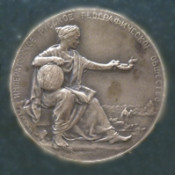
The Russian Geographical Society founded
On August 6 (18), 1845 under the imperial order of Nikolas I was approved the application of the Russian Domestic Affairs Minister count L. A. Perovsky for creation of the Russian Geographical Society in St. Petersburg which was later called the Imperial Russian Geographical Society.
In the first half of 19th century geographical societies were created in many European countries such as France, Germany, Great Britain, etc. by this time Russia has organized expeditions to explore Siberia, Transcaspian region, remote eastern and northern parts of the country.
In 1843 under the guidance of scholar and ethnographer P. I. Keppen the circle of statisticians and travelers began its regular meetings in order to discuss urgent questions of the national economy and statistical description of the country. Later the circle was joined by K. M. Bar, famous naturalist and traveler and Admiral F. P. Litke, eminent navigator, researcher of Novaya Zemlya, head of round-the-world expedition of 1826-1829.
In spring of 1845 the issue of a Society organization rose. The imperial order was soon followed by the meeting of founders where the first full members of the Russian Geographical Society were elected. On October 7 (19), 1845 in the Imperial Academy of Science and Arts Conference Hall took place the first general meeting of the Russian Geographical Society full members which elected the Society Council. Opening the meeting F. P. Litke determined ‘geography development in Russia’ as the Society’s principal task.
The Society was to have four departments: of general geography, geography of Russia, statistics of Russia and ethnography of Russia. In accordance of its constant statute the names of the departments changed in 1849. The new departments were called as follows: of physical geography, of mathematical geography, of statistics and of ethnography. In the beginning of 1850s the Society included the first regional branches – Caucasus branch in Tbilisi and Siberia branch in Irkutsk. Then more departments were opened in Orenburg, Wilno (North-West), in Kiev (South-West), in Omsk (West-Siberia), in Khabarovsk (Outer Manchuria), in Tashkent (Turkestan).
The first president of the Society was the second son of Nikolai I, Grand Duke Konstantin. After his death the Society was headed by the Grand Duke Nikolai Mikhailovich. Since 1917 the presidents were elected.
The principal object of the Russian Geographical Society had always been collection and distribution of reliable geographical information. Society’s expeditions had played a significant role in exploration of Siberia, Far East, Middle and Central Asia, World Ocean, in developing of navigation, discovering and research of new lands, formation of meteorology and climatology. The Society obtained world recognition owing to geographical discoveries made by its members in the middle and end of 19th century: the first research of Tian Shan by P. P. Semyonov (1856-1857), long-term complex research of inner regions of the Central Asia by N. M. Przhevalsky (1870-1888), discovering of Toksun Depression and developing of a map of the East Turkestan by M. V. Pevtsov in 1890.
The Society also paid close attention to such disciplines as ethnography, archaeology, history, zoology, anthropology. It had organized the expedition led by N. N. Miklouho-Maclay to study the way of life and religious beliefs of New Guinea Papuans, and the expedition led by G. Ts. Tsybikov who was the first of the European scholars to penetrate into Lhasa, the capital of Tibet.
In the middle of 20th century the Society carried out a large series of researches in the Arctic and the Antarctic guided by M. M. Somov, A. F. Treshnikov, E. I. Tolstikov.
From the moment of the foundation the Russian Geographical Society put in place a large-scale publishing and enlightening activity: from 1846 to 1917 the “Notes of the Russian Geographical Society” had been issued, from 1865 has been published the ‘News of the Russian Geographical Society’, from 1952 has been issued ‘Collected works on geography’. The Society research archive is the oldest and the only special geographical archive in our country which holds unique documents of Russian travelers, scholars and diplomats.
Since 1956 the Russian Geographical Society is a member of the International Geographical Union.
At the present the Russian Geographical Society unites 27 000 members in all constituent territories of the RF and abroad; it numbers 127 regional and local branches and representative offices across the entire Russia. The Headquarters of the Russian Geographical Society is in St. Petersburg. The largest regional branches of the Society are Primorsky and Moscow ones. In November of 2009 the Head of the Ministry of Urgent Situations S. K. Shoigu was elected the president of the Russian Geographical Society.
Lit.: Берг Л. С. Всесоюзное Географическое общество за 100 лет. М.; Л., 1946; Географическое общество за 125 лет. М.; Л., 1970; История здания. Санкт-Петербург [Электронный ресурс] // Русское географическое общество. 2013-2015. URL: http://www.rgo.ru/ru/obshchestvo/shtab-kvartira-v-sankt-peterburge/istoriya-zdaniya; История РГО [Электронный ресурс] // Русское географическое общество. 2013-2015. URL: http://www.rgo.ru/ru/obshchestvo/istoriya; Лавров С. Б., Селиверстов Ю. П. Русское географическое общество. История и современность [Электронный ресурс] // Комиссия научного туризма Русского географического общества. 2004–2012. URL: http://www.knt.org.ru/Istori%20RGO%20KNT.htm; Русское географическое общество: 150 лет. М., 1995.
Русское географическое общество: сайт. 2013-2015. URL: http://www.rgo.ru.
Based on the Presidential Library’s materials:
Записки Западно-Сибирского отдела Императорского Русского географического общества. 1879-1916;
Записки Приамурского отдела Императорского Русского географического общества. Хабаровск, 1894-1914;
Записки Императорского Русского географического общества. СПб., 1846-1864;
Записки Императорского Русского географического общества. По общей географии. Пг., 1867-1916;
Записки Императорского Русского географического общества. По отделению статистики. ПГ., 1866-1915;
Записки Императорского Русского географического общества. По отделению этнографии. Пг., 1867-1925;
Записки Сибирского отдела Императорского Русского географического общества. Иркутск, 1856-1886;
Полное собрание законов Российской Империи. Собрание 2-е. СПб., 1846. Т. 20 (1845). № 19259;

